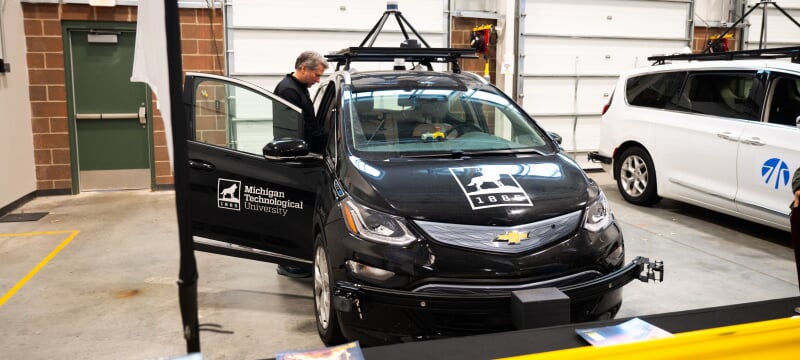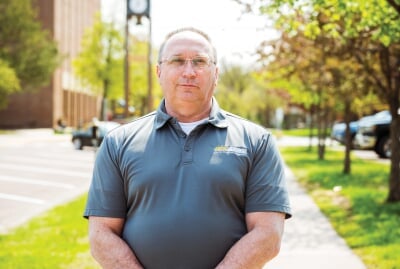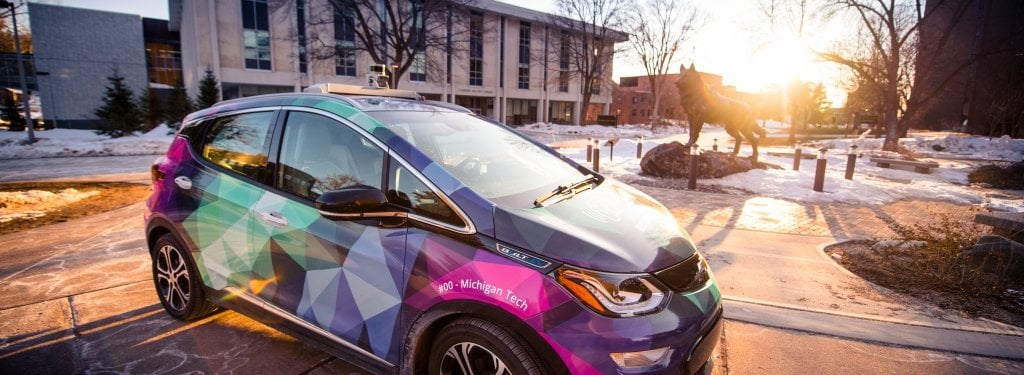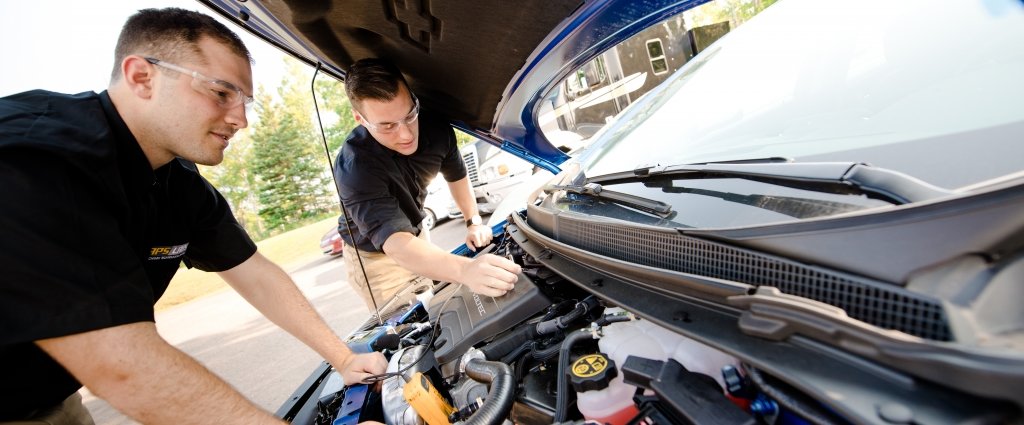CAVs—connected and autonomous vehicles—are set to transform transportation. A collaboration of Michigan Tech research teams stand at the forefront of this automotive revolution.
As CAVs move from research labs to real-world deployment, researchers at the Michigan Tech Research Institute (MTRI) and Advanced Power Systems Laboratories (APS Labs) are helping to answer critical questions about how these systems will perform in less-than-perfect operating conditions. In doing so, they are pushing the boundaries of what vehicles can achieve.
Michigan Tech is home to a federally funded initiative to develop, validate, and demonstrate a suite of energy-saving technologies on connected electric vehicles. The project is a partnership between the University and General Motors, and has received over $7 million in support from the ARPA-E NEXTCAR Program—an initiative of the US Department of Energy's (DOE's) Advanced Research Projects Agency–Energy. It's also a collaboration between Bill Buller, senior research scientist at MTRI, and Jeffrey D. Naber, director of APS Labs—and is rooted in both labs' innovation and technical expertise.
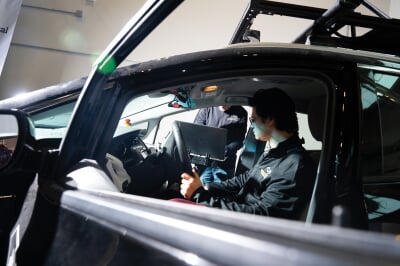
Both MTRI and APS Labs are deeply embedded in vehicle research, and their strengths complement one another. APS Labs brings expertise in hardware development and vehicle integration, while MTRI focuses on the modeling and simulation needed to run complex, large-scale vehicle tests. Both are necessary for Michigan Tech's NEXTCAR project, which involves eco-routing, managing approaches and departures from traffic signals, and enabling cooperative driving between multiple vehicles to harmonize speeds. At the heart of the research is the goal of making connected and autonomous vehicles more energy efficient. The ARPA-E NEXTCAR Program focuses on developing connected vehicle technologies that can save energy through these cooperative driving approaches. Naber and Buller's field testing initially began as a model validation study funded by the DOE's Vehicle Technology Office. Their research has evolved and grown into follow-up projects like this one.
MTU's project has involved significant collaboration, says Naber—including work with Oak Ridge National Laboratory, the American Center for Mobility, and two major DOE labs. This extensive cooperation highlights the project's scale, focusing on testing and validation of connected vehicle technology. The project seeks to prove the energy-saving potential of these technologies, while also blending the digital world with the realities of the physical environment.
"The whole idea here is that we're mixing the digital and physical worlds," says Buller. "We don't have a fleet of connected vehicles, but with digital simulations, we can still see how these technologies interact with real cars."
These simulations help researchers safely evaluate technologies that may not yet be ready for widespread real-world use. Instead of needing a fleet of connected vehicles to test energy efficiency, the digital track allows researchers to simulate dozens of vehicles, then observe how one real vehicle responds to their presence. This blend of real-time simulation and physical vehicle testing is essential in validating the effectiveness of connected vehicle technologies.
"We created a digital version of the track where simulated vehicles talk to real cars," says Buller. "It lets us test these systems safely and more efficiently before full deployment."
"We're not just testing vehicles. We're helping to shape the future of transportation."
By enabling vehicles to communicate with one another and coordinate their actions, such as merging into traffic or maintaining optimal speeds, these systems can potentially reduce fuel consumption and emissions.
"Connected vehicles can save energy through cooperation," says Naber. "In simulations, they work together to coordinate speeds and actions to reduce fuel consumption, but the goal is to see how this translates into real-world energy savings."
From Simulations to Real-world Testing
While simulations play a crucial role in the early phases of research, the move from the controlled environment of a computer model to the unpredictable conditions of a physical test track is where researchers truly start to understand how these technologies will function in daily life. Real-world testing often exposes challenges researchers may not have anticipated. For instance, while simulations may predict significant energy savings, the real-world performance of connected vehicles can vary due to communication delays, infrastructure limitations, and environmental factors like snow and ice.
"We know simulations show great energy savings, but the real challenge is determining how well these connected vehicles work in real-world environments where communication isn't perfect," Naber says. "Things like changing weather or network delays can make a huge difference."
This is where Michigan Tech's unique environment provides a critical advantage. The University's location in the Upper Peninsula offers access to a diverse range of testing conditions, from icy roads to rural highways, that are perfect for putting autonomous and connected vehicle technologies to the test.
"The real test comes when these technologies are deployed in unpredictable environments, where things don't always go as planned," says Buller. "In Michigan, where winters are particularly harsh, testing connected and autonomous vehicles is even more challenging. Our unstructured winter environment, with snow-covered roads and low visibility, is a perfect test bed for seeing how these systems handle extreme conditions."
Additionally, in 2024, Michigan Tech became the official engineering service provider for the American Center for Mobility (ACM), one of the premier testing centers in the US for connected and autonomous vehicles. Located in the urban southeast of Michigan's Lower Peninsula, the ACM offers a controlled environment where researchers can test vehicles on a variety of tracks, such as a highway loop, triple-decker overpass, urban canyon, tunnels, and designated pedestrian and bicycle corridors. These varied settings simulate real-world challenges and allow for rigorous evaluation of new vehicle technologies.
"Most of our work with ACM has been federally funded," says Naber. "But this new partnership allows us to work directly with industry, supporting their development and validation needs."
With access to the ACM's infrastructure and smart city simulation areas, Michigan Tech can conduct testing that requires both structured and unstructured environments, allowing researchers to anticipate and address real-world issues. The ACM facilities provide a seamless bridge between the lab and the road, preparing Michigan Tech's connected vehicle technologies for broad deployment.
"The scale of what we're able to do with ACM is a game changer," says Buller.
As CAVs become more common in the marketplace, and as CAV technologies continue to evolve, the mobility research being done at Michigan Tech will become increasingly important. With field testing continuing through the next phases of the NEXTCAR project, and with Tech's partnership with the ACM offering new opportunities for scaling and collaboration, Michigan Tech is poised to lead the way in connected and autonomous vehicle research.
Michigan Technological University is an R1 public research university founded in 1885 in Houghton, and is home to nearly 7,500 students from more than 60 countries around the world. Consistently ranked among the best universities in the country for return on investment, Michigan's flagship technological university offers more than 120 undergraduate and graduate degree programs in science and technology, engineering, computing, forestry, business, health professions, humanities, mathematics, social sciences, and the arts. The rural campus is situated just miles from Lake Superior in Michigan's Upper Peninsula, offering year-round opportunities for outdoor adventure.
